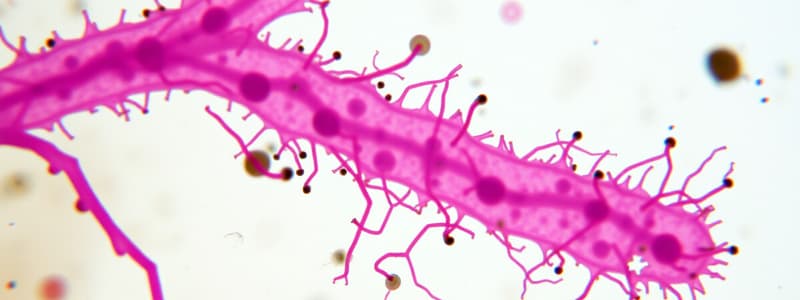Podcast
Questions and Answers
What are the differences between photoautotrophs, chemoautotrophs, photoheterotrophs, and chemoheterotrophs?
What are the differences between photoautotrophs, chemoautotrophs, photoheterotrophs, and chemoheterotrophs?
- Photoautotrophs get energy from light and carbon from inorganic compounds. (correct)
- Chemoheterotrophs get energy from chemicals and carbon from inorganic compounds. (correct)
- Photoheterotrophs get energy from light and carbon from organic compounds. (correct)
- Chemoautotrophs get energy from chemicals and carbon from organic compounds. (correct)
What is osmosis, and what do red blood cells do when placed in a hypotonic, hypertonic, or isotonic solution?
What is osmosis, and what do red blood cells do when placed in a hypotonic, hypertonic, or isotonic solution?
Osmosis is the diffusion of water across a selectively permeable membrane. In a hypotonic solution, red blood cells swell and burst (lyse). In a hypertonic solution, they shrink (crenate). In an isotonic solution, they neither swell nor shrink.
What is the difference between mesophiles, psychrophiles, and thermophiles?
What is the difference between mesophiles, psychrophiles, and thermophiles?
Mesophiles grow at temperatures between 10-50 degrees C, psychrophiles thrive at low temperatures (optimum below 15 degrees C), and thermophiles require temperatures above 45 degrees C.
What are the differences between obligate aerobes, microaerophiles, facultative anaerobes, strict anaerobes, and aerotolerant anaerobes?
What are the differences between obligate aerobes, microaerophiles, facultative anaerobes, strict anaerobes, and aerotolerant anaerobes?
Flashcards are hidden until you start studying
Study Notes
Metabolic Types of Microbes
- Photoautotrophs: Obtain energy from light and carbon from inorganic compounds.
- Chemoautotrophs: Derive energy from chemical reactions and use inorganic compounds for carbon.
- Photoheterotrophs: Get energy from light, but carbon comes from organic compounds.
- Chemoheterotrophs: Acquire energy and carbon both from organic compounds.
Osmosis and Red Blood Cells
- Osmosis: The process of water diffusion across a selectively permeable membrane.
- Hypertonic solution: Causes red blood cells to lose water and shrink (crenate).
- Hypotonic solution: Leads to water intake by red blood cells, resulting in swelling and possible bursting (lyse).
- Isotonic solution: Red blood cells maintain their size without swelling or shrinking.
Temperature-Dependent Microbial Growth
- Mesophiles: Thrive in moderate temperature ranges, typically between 10 and 50 degrees Celsius.
- Psychrophiles: Prefer cold environments, able to grow near 0 degrees Celsius with optimal growth below 15 degrees Celsius.
- Thermophiles: Require high temperatures for growth, generally above 45 degrees Celsius.
Aerobic vs. Anaerobic Microbial Categories
- Obligate aerobes: Necessitate oxygen for growth and metabolism.
- Facultative anaerobes: Can grow without oxygen, but can also utilize oxygen when available.
- Strict anaerobes: Cannot grow in the presence of oxygen due to lack of necessary enzymes, and exposure results in death.
- Aerotolerant anaerobes: Do not use oxygen, but can survive and grow in its presence without being harmed.
Studying That Suits You
Use AI to generate personalized quizzes and flashcards to suit your learning preferences.



